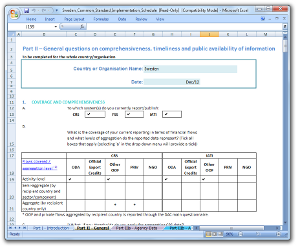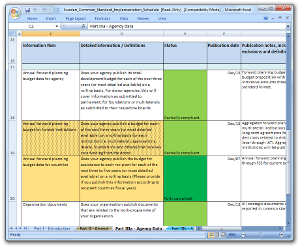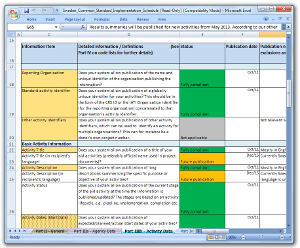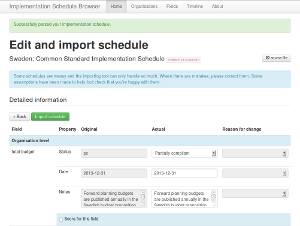Aid Transparency Tracker: Plan
This section of the Tracker looks at what different donor organisations are planning to publish. We will release more detailed analysis for the launch of the 2016 Aid Transparency Index.
Purpose
Since agreeing a common standard for publishing aid information at the 4th High Level Forum on Aid Effectiveness at Busan in 2011, donor organisations and governments have released implementation schedules outlining their plans to meet this commitment. Their target date for publishing timely, comprehensive and forward-looking information on resources for development co-operation is the end of 2015.
Specifically agreed at Busan, implementation schedules are important components of the transparency process, laying out an organisation's intentions to publish to the common standard. The schedules contain a great deal of new information on plans and systems. This information needs to be analysed in order to understand what donors are setting as their own targets and timeline for meeting the commitments they made at Busan. Publish What You Fund carried out detailed comparative analysis of the implementation schedules in order to take stock of progress, highlight trends and provide feedback on discrepancies in interpretation and approaches.
The information collected in the Plan and Publish sections provides the data for the annual Aid Transparency Index.
Methodology
Publish What You Fund developed an online application in order to assess and compare the various donor implementation schedules currently available. The application has been designed to read the common standard schedules and presents the findings in an accessible format that allows them to be compared across organisations. It provides information on each field included in the standard, when each field will be published by different organisations, as well as an overall timeline for publication.
Organisation selection criteria
Organisations that have published implementation schedules (collected together on the OECD Common Standard website) are included in this analysis. Many endorsers of the Busan Partnership for Effective Development Co-operation are yet to publish their schedules. (The full list of countries, territories and organisations that the template was sent to by the OECD is available on the OECD website.) As and when these organisations publish their schedules, they will be added to this analysis.
Scoring criteria
Organisations' schedules are assessed on three key criteria:
- Intention to publish;
- Publication approach;
- Fields coverage.
| 1. Intention to publish | |
| Tick | Stating intention to publish to the IATI component of the common standard with an explicit time frame indicated |
| 2. Publication approach | |
| Tick | Open licence (public domain or attribution-only) and at least quarterly publication |
| Tick | Open licence or quarterly publication, but not both |
| Neither open licence nor quarterly publication | |
| 3. Fields | |
| 0-100% |
A point is awarded for planning to publish by a specific date for each agency and activity-level field in the standard Each field received a point if the publication status is marked 'fully compliant', 'future publication' with an explicit target date or 'partially compliant' with supplementary text suggesting plans for future publication by a specific target date. Where there are contradictions between the status and the accompanying text descriptions, organisations are not scored even if the publication status was marked 'fully compliant.' Any changes made are presented in the changes box alongside each field on the organisation's page. Fields are grouped under the sub-headings used in the common standard template All groups are weighted equally, as were all fields within each group, to arrive at a final score in the range of 0 to 100. |
Grouping
Organisations' implementation plans have been categorised into groups based on the following criteria:
| Group | Intention to publish | Publication approach | Fields |
|---|---|---|---|
| Ambitious | Tick | TickTick | 60-100% |
| Moderately ambitious | Tick | Tick | 40-59% |
| Unambitious | Tick | 1-39% |
Some organisations cannot be grouped into any of the above groups, and are categorised as follows:
| Under consideration | Organisations that are actively considering publication |
| Incomplete | Organisations that have submitted implementation schedules without providing any agency or activity level information |
| No publication | Organisations that have no plans to publish to the IATI component of the common standard |
Notes
The following assumptions were made in order to ensure that the data was comparable across organisations:
- Not answering a question was understood as a "no" and received no score.
- Using only the year in a date field was understood as the last day of the year (and using only the month was interpreted as the last day of that month).
- The initial implementation date was used as the minimum publication date for all elements.
- If the publication date for specific items was later than the initial implementation date, then that item-specific date was used instead.
In order to keep the methodology simple, fields which may not be applicable to all organisations, or where the format is still under consideration, are excluded from the analysis (and the total scores) of the level of ambition shown in various implementation schedules. These fields are:
- Transactions (Reimbursement)
- Transactions (Loan repayment / interest repayment)
- Activity website
- Sector (Agency specific)
- Other Identifier
- Related Activity
- Participating organisation (Accountable)
- Participating organisation (Extending)
- Budget identifier (Administrative/functional)
- Budget identifier (Economic)
We welcome feedback on whether any of these fields should be included in our analysis or if there are other fields that should be added to the list above.
The scores and groups reflect only the level of ambition demonstrated by donors in their implementation schedules and not the quality or veracity of data that is currently being or will be published. In addition, because of the apparent variation in the way donors have understood and completed different fields within the schedules, some interpretation on our part has been inevitable to ensure consistency and comparability across templates. All changes made to the data are marked with the changes icon, which you can click to see details of the changes made. Donors may wish to review their schedules and contact Publish What You Fund on matters where they note discrepancies. For these same reasons, organisations have not been ranked according to their total scores at this point in time.
Process
Analysing and processing the common standard schedules has required a detailed look at each implementation schedule, as well as interpreting them when organisations have completed them in different ways or understood the various options differently.
The original implementation schedules
The implementation schedules were published in individual Excel files, containing three main sheets: general, agency, and activity-level information.
-

General
Approach to publication: includes timeliness and frequency, licence, initial publication dates, scope of publication.
-

Agency
Agency-level publication: includes country budgets, organisation documents.
-

Activity
Activity-level publication: includes information about when the organisation will (or won't) be compliant with each field in the standard.
Templates
While there is a template for the common standard implementation schedules, several different templates exist, and organisations further added to this complexity by modifying the templates, changing options, and adding and deleting rows – in all, we counted 11 different versions. Importing the schedules proved difficult because of this. In addition, some organisations published their Excel-based templates in PDF format, which made it impossible to automatically parse (or read) them. In these cases, it was necessary to copy the same data into new spreadsheets. While the data was thoroughly checked, it is possible that some human error will have resulted. Some interpretation was necessary to ensure consistency and comparability across the schedules (see notes section above).
Importing
The schedules were automatically parsed and imported into this application. Publish What You Fund then checked the resulting data to ensure that it had been parsed correctly and that it made sense.
-

Select a file
The user can select a schedule from any publicly-accessible URL. This could be the OECD/DAC common standard website, the IATI website, or the donor's own website.
Where the original schedules could not be automatically parsed (e.g. because they were in PDF), a new spreadsheet was created by Publish What You Fund using the information included in the original schedule.
-

Successfully parsed
The schedule was successfully parsed and is presented to the user to check and correct.
-

Check fields
Make sure that all information has been parsed correctly, ensure that compliance status is consistent with notes, and score for partially compliant fields if the publisher has understated their publication relative to other donors.